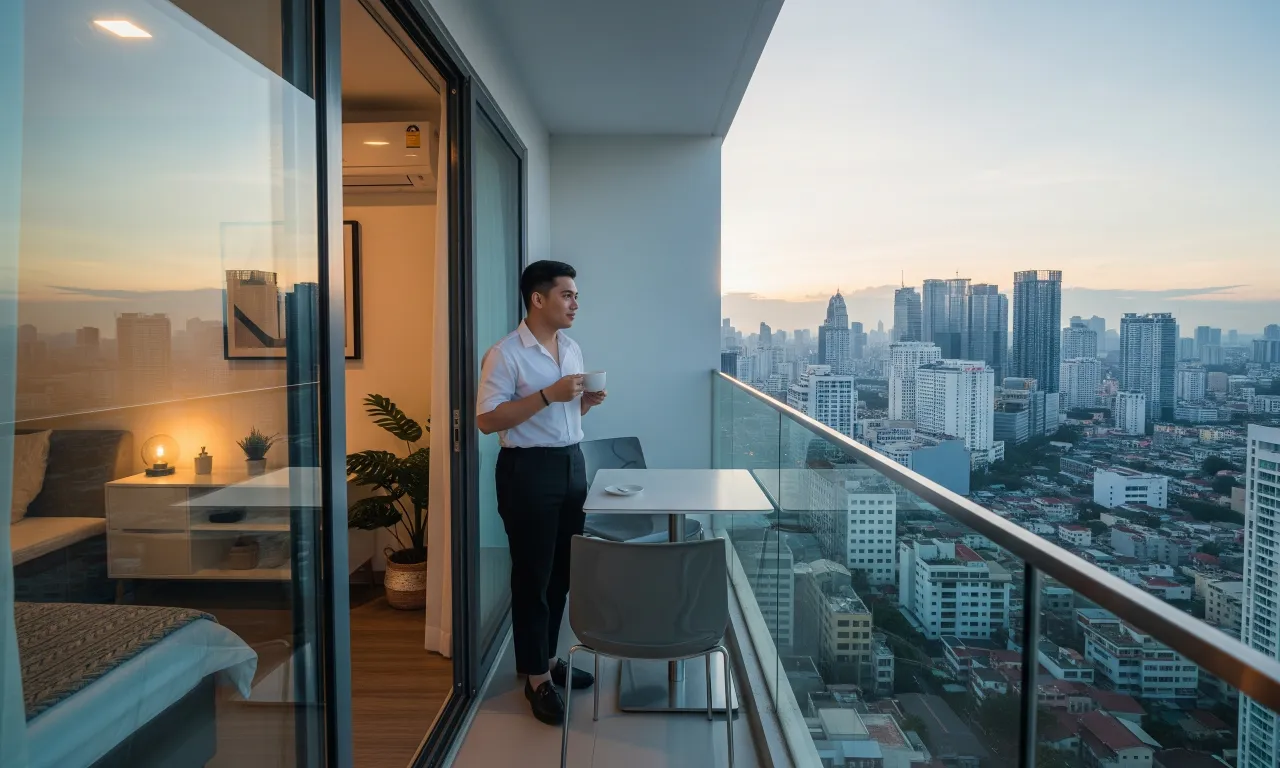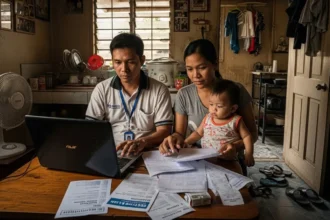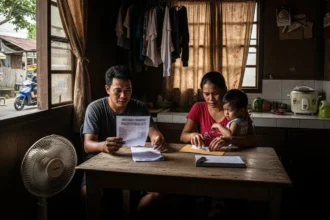Once upon a time, the dream was simple – bahay at lupa. A home with a small garden, a gate, maybe even a sari-sari store on the side. But for today’s generation? The dream has gone vertical.
- 💸 The Shift: Why Young Filipinos Prefer Condos Over Houses
- 📉 The Trade-Offs: Hidden Costs and Real-Life Challenges of Condo Living
- 📈 The Smart Way: Making Condo Living a Wise Financial Move
- 🏡 Condo vs. House: Which One Truly Fits the Filipino Dream?
- 💬 FAQs About Condo Living in the Philippines
- Redefining the Filipino Dream
- 🧭 References
Across Metro Manila, Cebu, and Davao, more young Filipinos are trading big yards for big views. Condo living in the Philippines has become the new definition of success – sleek, practical, and close to everything that matters. From early morning coffee runs in BGC to late-night grocery trips downstairs, the high-rise life promises convenience that fits the modern grind.
But let’s be honest – convenience comes with a price tag.
Monthly dues, smaller spaces, and long-term investment questions make many still wonder: Is condo living really worth it?
For some, it’s a smart financial move – no need to buy land, less maintenance, and a chance to own property in prime city areas. For others, it’s a lifestyle choice – trading space for accessibility, stress for structure, and traffic for time.
Whatever the reason, one thing’s clear: condo living isn’t just a real estate trend – it’s a reflection of how young Filipinos are reshaping the idea of home, adulthood, and ambition in today’s fast-changing world.
💸 The Shift: Why Young Filipinos Prefer Condos Over Houses
Ask any millennial or Gen Z today what their “dream home” looks like, and you’ll hear something different from what our parents used to say.
Gone are the days when owning a house and lot in the suburbs was the ultimate goal. Now, the dream is smaller – but higher.
🏢 1. Location Over Lot Area
Let’s be real – location is everything.
With endless traffic and long commutes, living near work or school isn’t just a luxury anymore – it’s survival. Condos give that convenience. You can wake up at 7:30, log in by 8:00, or walk to your office in five minutes flat.
Whether it’s a unit in Makati, Ortigas, or Cebu IT Park, young professionals would rather pay for location than spend three hours stuck on EDSA. Because at the end of the day, time is now the new currency.
🏠 2. Less Maintenance, Less Stress
Condo living means you don’t have to worry about cutting grass, fixing leaks, or painting the gate every year.
Everything is managed – from the garbage collection to security and even the gym downstairs. For OFWs or work-from-home professionals, that’s a big win.
No need to worry about pests, floods, or unexpected repairs that can drain your savings. You just pay your dues and live your life.
As one condo owner put it: “Hindi ko na kailangan ng malaking bahay. Gusto ko lang ng bahay na hindi hassle.”
💳 3. Financial Accessibility
Let’s talk numbers.
Buying a house in Metro Manila now easily costs ₱6–₱10 million, excluding maintenance, while many condos start at around ₱2–₱3 million – payable through flexible terms or pre-selling options.
For young earners, that makes ownership feel possible. Developers also make it easier with no downpayment, 0% interest, or rent-to-own promos.
And while condos may be smaller, they serve as stepping stones – a first property, a passive income source (Airbnb, anyone?), or even a long-term investment once fully paid.
🌇 4. Lifestyle and Status
Let’s admit it – there’s a social element too.
Condo living looks and feels modern. You’re near cafés, coworking hubs, and malls. You can host friends, use the pool, or post a weekend view that screams “city life goals.”
It’s not about showing off – it’s about belonging to a generation that values experience over excess.
For many young Filipinos, condo living isn’t just shelter – it’s identity.
🧠 5. Independence and Simplicity
There’s also the emotional side. Condo living teaches independence – paying your own bills, managing your own space, making small but proud adult decisions.
It’s minimalism in action: less clutter, less stress, less maintenance. And in a world where everything feels complicated, that simplicity feels like luxury.
For the generation raised on hustle culture, it’s the peace they didn’t know they needed.
Condo living may not be for everyone – but for this generation, it’s not just about where they live.
It’s about how they want to live: freely, flexibly, and with more time to chase the things that matter.
📉 The Trade-Offs: Hidden Costs and Real-Life Challenges of Condo Living
Every glossy brochure and model unit screams “modern living” – white walls, big windows, rooftop pools. But behind that Instagram-perfect condo life are realities that not everyone sees (or budgets for).
Condo living has perks, yes – but it also has fine print. And if you’re not ready, those hidden costs can easily turn your dream unit into a monthly headache.
💸 1. The True Cost of Ownership
That ₱10,000 monthly amortization you saw on the ad? That’s just the start.
Here’s what most first-time condo buyers forget to factor in:
- Association dues: ₱1,000–₱3,000 per month depending on your unit size and amenities.
- Property taxes and insurance: ₱10,000–₱20,000 annually.
- Utilities: Separate electric and water meters mean higher minimum charges.
- Parking: Not always included – can cost as much as a small studio unit.
And if you’re thinking of buying pre-selling units, delays can stretch your patience (and your rent payments) for years.
🧱 2. Space (or the Lack of It)
Let’s be honest – most condos in Metro Manila aren’t built for families.
A typical studio unit is around 22–30 square meters – basically the size of a small bedroom. For single professionals, that’s cozy; for a couple with kids, that’s chaos.
You can make it work with smart storage and minimalist design, sure. But if you’re used to having a backyard or laundry space, the adjustment can be real.
Many condo dwellers eventually confess:
“Ang ganda ng view, pero minsan gusto ko lang lumabas at huminga.”
⚙️ 3. Monthly Dues, Forever
Owning a condo doesn’t mean you’re done paying.
Those monthly association fees never go away. They cover security, maintenance, elevators, garbage collection, and more – all necessary, but often increasing over time.
Unlike a house where you can DIY repairs, condos have rules and limits.
Want to repaint? Need permission. Want to install a washing machine? Check the water line. Even hanging clothes on your balcony can sometimes be against the rules.
Convenience comes with conditions – and sometimes, those feel tighter than the floor space.
🧾 4. Resale and Value Appreciation
Here’s another truth few developers mention: not all condos appreciate in value.
High supply in city centers means resale prices can stagnate, especially if newer buildings pop up nearby. Some units even lose value over time due to aging facilities or poor management.
In contrast, land traditionally grows in value. That’s why many still call it “the true long-term investment.”
So if you’re buying a condo, make sure you’re doing it for lifestyle, not just speculation.
🔒 5. The Emotional Cost
Condo living can feel lonely, especially for those used to provincial life.
You might miss simple things – seeing neighbors, open skies, family dinners. The “modern life” can feel isolating behind concrete walls and elevator silence.
Sure, you have privacy. But sometimes, you’ll catch yourself staring out the window at city lights, wondering what it’d be like to trade that view for quiet grass and stars.
Still, many condo owners will tell you – they don’t regret it. Because in the middle of the noise, they found something that’s hard to find in Metro Manila: control.
Control over their time, their space, and the life they’re building – one square meter at a time.
📈 The Smart Way: Making Condo Living a Wise Financial Move
Not all condo owners end up struggling. In fact, many have learned how to make their small space – and monthly payments – work smarter, not harder.
Because while condo living can be expensive, it can also be strategic. You just need to treat it like what it truly is: both a home and an investment.
💵 1. Think Like an Investor, Not a Tenant
Before signing that contract, ask yourself: “Is this for comfort or for capital?”
If you plan to live there long-term, look for developments with:
- Reliable property management (clean, secure, efficient)
- Accessible location (near transport hubs, malls, schools)
- Steady water and power systems (a dealbreaker if unreliable!)
But if you’re thinking about future resale or rental, focus on:
- Units near business districts or universities
- Those with high walkability and good amenities
- Flexible leasing rules (some condos allow Airbnb, others don’t)
The goal is to make sure your investment can still earn – even while you’re not there.
🧾 2. Be Realistic About Your Budget
Many first-time buyers fall into the “kaya na siguro ‘to” trap. Don’t.
Before buying, list all the costs – amortization, association dues, utilities, insurance, and parking. Then add 10% as buffer for emergencies.
A good rule of thumb:
Your monthly condo expenses shouldn’t exceed 30–35% of your take-home pay.
Otherwise, you’re not buying a home – you’re buying stress.
And don’t forget to read the fine print – especially on pre-selling units. Delivery delays and hidden charges can easily mess up your cash flow.
🏠 3. Turn Your Condo Into Income
A condo can be more than just a place to sleep.
If you travel often or live elsewhere part of the year, rent your unit out short-term. Platforms like Airbnb, Facebook Marketplace, and Lamudi make it easier than ever.
Some owners also convert their condos into:
- Home offices or creative studios
- Student rentals near schools
- Co-living or shared spaces with split bills
With good maintenance and proper documentation, your condo can quietly earn you ₱10,000–₱25,000 per month depending on size and location.
📊 4. Use Condo Ownership as a Financial Stepping Stone
A condo doesn’t have to be your “forever home.”
Many successful homeowners started with a small unit in their 20s, built equity, and later upgraded to a house or bigger property in their 30s.
It’s all about momentum.
Pay consistently, avoid default, and build your credit profile – it makes future property loans easier to secure.
Your first condo might be small, but it’s proof that you can own something in the city – and that’s already a huge step toward financial independence.
🧠 5. Balance the Lifestyle and the Long Game
At the end of the day, condo living is about balance.
Enjoy the convenience, but don’t let it drain your savings. Take advantage of the gym and amenities, but resist lifestyle inflation – that subtle push to “live beyond your means” just to fit the vibe.
You don’t need the biggest unit or the flashiest location. What you need is a space that serves your life goals, not the other way around.
Because the smartest condo owner isn’t the one with the best view – it’s the one who can still sleep peacefully at night, knowing the bills are paid and the investment is growing.
🏡 Condo vs. House: Which One Truly Fits the Filipino Dream?
The Filipino dream used to be simple – a house with a gate, a tricycle parked outside, and neighbors who greet you every morning.
But in today’s reality of rising costs and shrinking space, that dream has started to evolve.
Now, we’re asking: Is it still practical to chase the bahay at lupa dream, or is condo living the smarter move?
💰 1. Cost Comparison: Land vs. Location
Owning a house and lot still gives long-term stability – no association dues, bigger space, and land that appreciates over time. But it comes with heavier upfront costs:
- Metro Manila: Houses can start at ₱6–₱15 million.
- Condo units: Smaller, but can start from ₱2–₱3 million in key cities.
However, location changes everything.
A house in the province might be cheaper, but if your job’s in Makati, the daily commute eats up both money and time.
Condo living may cost more monthly, but the proximity to work, school, and amenities can save you thousands in transportation – and hours of sanity.
🧍♂️ 2. Lifestyle: Community vs. Convenience
In a traditional home, you have space – gardens, pets, loud karaoke nights.
But with space comes maintenance, and that means time, money, and effort.
Condo living trades those for convenience. You get security, accessibility, and amenities like pools and gyms that make daily life smoother.
It’s more private, yes – but also more solitary. You don’t have kapitbahay chika or spontaneous street basketball with friends.
So the question isn’t just about money – it’s about what kind of life you want.
🏠 3. Ownership: Forever vs. Flexible
A house is forever – a legacy, something to pass down.
A condo, by contrast, often comes with a 50-year lifespan (based on property law) before the building can be sold, redeveloped, or demolished.
That sounds scary, but here’s perspective: 50 years is still a lifetime for one generation.
For many, it’s a stepping stone – the first real estate they could afford and manage.
Owning a condo doesn’t mean giving up the dream of land ownership – it’s just taking a different route toward it.
💡 4. Emotional Value: Stability vs. Freedom
A house feels like permanence – roots. A condo feels like motion – freedom.
For older generations, the house was proof of success. For today’s generation, success looks different: it’s having flexibility, mobility, and time for experiences.
Neither is wrong – they’re just reflections of different seasons in life.
You might want a condo in your 20s and a quiet house in your 40s. Both can be valid dreams.
🧠 5. The Verdict: It’s Not Either-Or
The Filipino dream doesn’t have to be boxed in. It’s evolving – from the backyard to the balcony, from the garage to the parking basement.
The real dream is financial freedom – to live comfortably, wherever you are, without drowning in debt.
Whether it’s a two-story house in Cavite or a one-bedroom condo in Pasig, what matters is this:
you’re building something that fits your story, your budget, and your peace of mind. ❤️
💬 FAQs About Condo Living in the Philippines
1. Is condo living in the Philippines worth it?
Yes – if your lifestyle fits it. Condos offer convenience, security, and accessibility that’s hard to find in city houses today. But they also come with recurring costs like dues and maintenance. If you value location and time over space, condo living can be worth every peso.
2. How much does it really cost to live in a condo?
Beyond your monthly amortization or rent, expect ₱2,000–₱4,000 in association dues, utilities, and maintenance fees. Parking slots, internet plans, and repairs can also add to your monthly expenses. If you’re buying, factor in property tax and insurance too. Always make a realistic budget – condo living is comfort with commitment.
3. What are the pros and cons of owning a condo vs. a house?
Condos are easier to maintain, safer, and closer to workplaces – perfect for professionals or small families. Houses, meanwhile, offer more space and land ownership that appreciates over time. Condos give flexibility; houses give permanence. Your choice should depend on your goals – short-term convenience or long-term stability.
4. Do condos lose value over time?
It depends. Prime condos in great locations (like Makati or Cebu Business Park) tend to maintain or increase in value, especially if managed well. Older buildings or those in oversaturated areas might depreciate. The key is choosing the right location and developer with a good track record.
5. Can you inherit or pass down a condo?
Yes, you can – condo ownership is transferable just like land. However, under Philippine law, buildings have a 50-year lifespan before redevelopment. That means your heirs can still benefit from the property, but the land and structure may eventually be managed or sold collectively by the condo corporation.
6. Is it cheaper to rent or buy a condo in the long run?
If you plan to stay for less than five years, renting is often cheaper. But if you’re staying long-term or want to build equity, buying makes more sense. Rentals are flexible but temporary; ownership is commitment with potential returns. It’s about where you see yourself – not just next year, but in the next decade.
7. What are the hidden costs of condo ownership?
Many first-time buyers forget about association dues, special assessments, and furnishing costs. Renovations, appliances, and parking fees can easily add ₱100K–₱300K to your initial investment. You also pay for security, elevators, and shared utilities through monthly fees. Always ask your developer for a full cost breakdown before signing.
8. Can I earn from my condo investment?
Definitely! Many condo owners earn through long-term leasing or short-term rentals on platforms like Airbnb. You can also use it for co-living setups or student housing near universities. As long as your building allows it and you maintain the unit well, your condo can double as a steady income stream.
9. What happens if the condo building reaches 50 years old?
Once a building is deemed unfit or too old, the condo corporation (all unit owners) can vote to redevelop, repair, or sell the property. You won’t lose your investment outright – you’ll get a share of the proceeds or a stake in the new development. Still, it’s wise to invest in newer projects with strong management and high upkeep standards.
10. How can I make condo living more affordable?
Choose a pre-selling unit with flexible payment terms, or buy from resale owners who need fast cash. Share expenses with a roommate, use energy-saving appliances, and track bills monthly. Skip premium amenities you don’t use (like gyms or function halls). Most of all, budget with intention – the goal is peaceful living, not pay-slip panic.
Redefining the Filipino Dream
Maybe the Filipino dream was never just about owning a house with a gate – maybe it’s about having a space that fits your life today.
Condo living isn’t about abandoning tradition; it’s about adapting to reality. It’s the modern version of stability – smaller, higher, but still built with hope. For some, it’s a stepping stone. For others, it’s a symbol of independence. For everyone, it’s proof that progress doesn’t have to look the same for every generation.
Whether your window opens to a skyline or a garden, what matters is that you have a place to rest, recharge, and dream again. 🏙️🌿
Because the true measure of success isn’t how big your home is – it’s how much peace you find inside it.
🧭 References
-
Vista Residences – Condo Market Outlook in the Philippines
-
Crown Asia – Frequently Asked Questions: Condo Living
-
Global Property Guide – Philippines Residential Property Market 2025
-
Philstar – Condo Living in the Philippines
-
BusinessWorld – Condominium Living Further on the Rise










